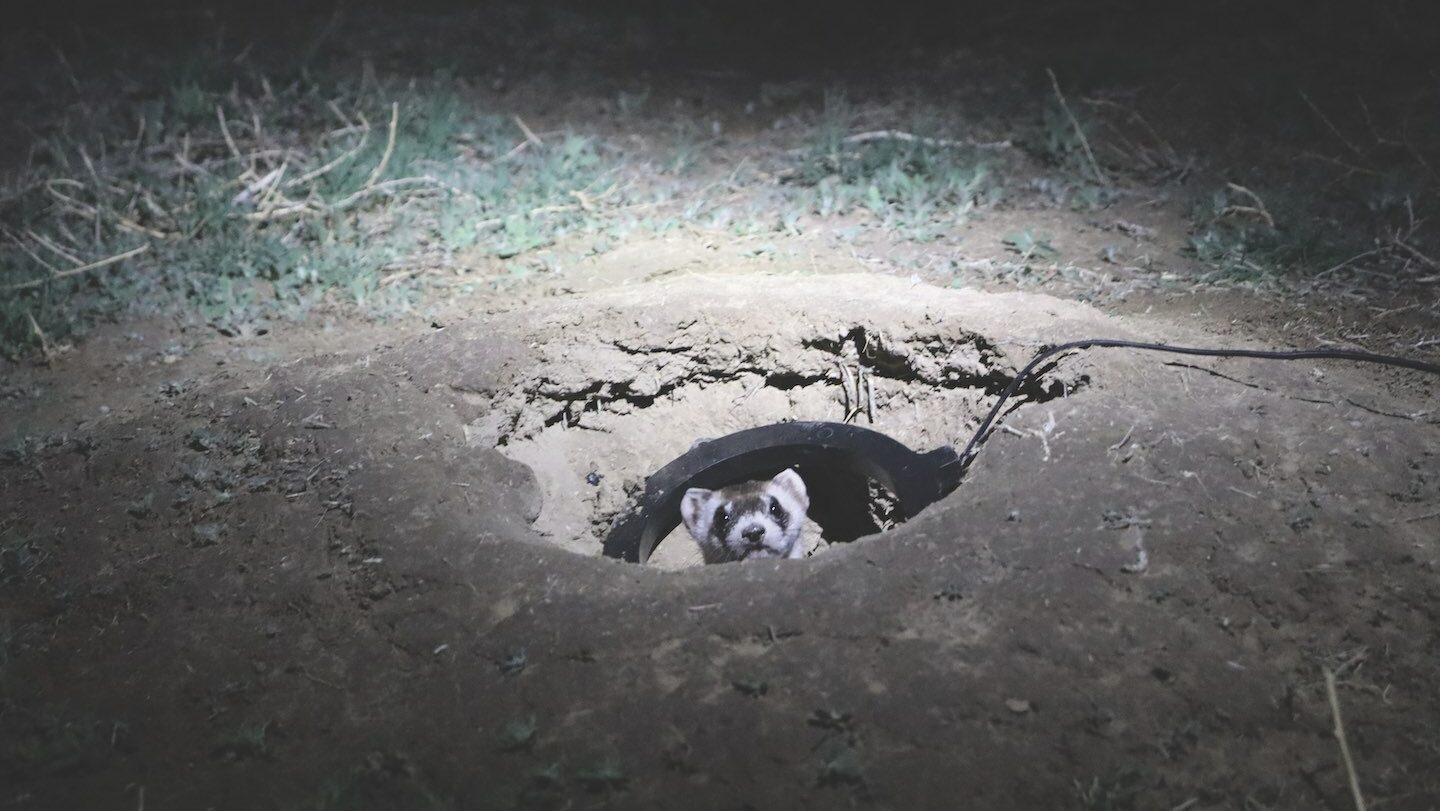A comeback for the ages

Black-footed ferrets were once counted out.
Their remarkable recovery now depends on creative collaboration between landowners and public wildlife managers.
The rain finally let up, and the thunder quieted to a distant rumble. We pulled the truck out onto the shortgrass prairie, switched on two high-powered spotlights and started a slow roll downhill. Then I saw it: a tiny emerald green reflection in my spotlight. I gasped, and the others in the truck instinctively turned to look.
“Yeah, I think that’s a ferret, guys,” said the Colorado Parks and Wildlife biological technician driving the truck.
We parked, keeping a spotlight pointed at where the ferret’s eyeshine had been, and started to gather equipment: headlamps, a clipboard and a waterproof case that held a special device I had hoped to see in action: a pit tag reader.
As we walked in the headlights toward the burrow, we cast immense shadows across the prairie. Yet the green emeralds stayed visible as we approached. The ferret was checking us out, a sign it was likely one of the reintroduced ferrets released here on the May Ranch outside of Lamar, Colorado, last fall.
The CPW tech set the plastic ring of the pit tag reader over the burrow entrance just above the curious ferret, who had ducked down to hide. The ferret popped back up, and the reader gave a sharp beep, loud in the midnight silence. This was definitely a reintroduced ferret, with an RFID microchip, or pit tag, implanted between its shoulder blades.
Mysterious predator of the prairie
Black-footed ferrets are the most critically endangered mammal in North America. There are likely no more than a few hundred in the wild.
Many scientists had concluded they were extinct by 1981, when a ranch dog in Meeteetse, Wyoming killed what the rancher, John Hogg, assumed was a mink. The taxidermist, however, called the Wyoming Department of Game and Fish, telling Hogg it was an endangered species. This set off, according to a 1985 article in the Los Angeles Times, “ferretmania,” as researchers and wildlife-lovers alike descended on the town. The article noted that researchers estimated as many as 130 ferrets living on the Hogg’s Pitchfork Ranch. But soon after, ferret numbers mysteriously began to plummet. By 1986, only 18 were left.
Seven of these remaining ferrets were captured and brought into a federally led breeding program. It was just in time. By 1987, the remaining known wild ferrets were missing, presumed dead.
Down with disease
The mysterious cause of death turned out to be disease, a problem that literally plagues ferrets. Sylvatic (meaning wildlife) plague is caused by the bacteria Yersinia pestis, transmitted by fleas, which also caused Europe’s Black Death in the Middle Ages. It devastates prairie dogs, ferrets and other mammals.
There is a vaccine, however. Every ferret reintroduced to the wild is vaccinated. But that doesn’t prevent their sole food source—prairie dogs—from contracting the disease. Which brings us back to the May Ranch and the reintroduction program taking place there.
“It took us 10 years of work to get ourselves approved,” said Dallas May, the fourth generation of Mays to ranch here. May became a Colorado Parks and Wildlife commissioner after the reintroduction work had started and is on the board of Western Landowners Alliance.
The work was creating more space for prairie dogs: in essence, more native prairie. This meant adjusting grazing plans, seeding native grasses, controlling weeds and more. Today, more than 1,500 of the May Ranch’s 9,000 acres support prairie dog colonies. That’s the minimum number of acres of prairie dogs to be considered for a reintroduction site, according to Jonathan Reitz, regional biologist for Colorado Parks and Wildlife in Lamar and leader of the state’s ferret reintroduction program.
But acres of colonies are not enough. The Mays have agreed to an intensive “plague protocol” in which CPW treats those 1,500 acres of prairie dogs against plague. “That’s what a landowner like Dallas May has agreed to,” said Reitz, “[CPW is] spending a lot of time on his ranch putting out flea powder and putting out baits (with medicated flea control) and mapping his prairie dog colonies.”
“The day we brought the ferrets out, we released 20 of them at specific holes,” said May, “and then it’s a wait and see game.”
“We’re now into the series where we do quarterly survey on our prairie dog colonies to make sure that they’re not diminishing, to make sure that they’re stable and maybe even expanding,” he said, a hint of pride creeping into his usual matter-of-fact delivery, “which, they actually are expanding.”
Fulfilling their purpose
The May Ranch is one of just 30 black-footed ferret reintroduction sites. And their homeland remains one of the most threatened ecosystems in North America. To the Mays, that means that prairie dogs and black-footed ferrets deserve a place on their ranch, just as they do.
“We believe everything was created to fulfill its purpose,” Riley May, Dallas’s son, told On Land, “and everything works together to coexist.”
“This last fall, besides the other ferrets we released on the ranch, the team brought five females, and they put those five females in about a half mile circle around this male,” said Dallas May, gesturing out across the miles of grass he tends. “Hopefully by next fall we will have the chance to have some kits on the ground.”





